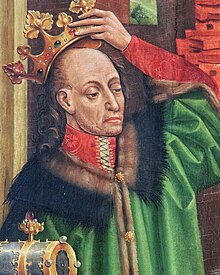Władysław II Jagiełło
Jogaila ( Belarusian Ягайла ; * before 1362; † June 1, 1434 in Gródek ) was Prince of Kiev in 1377 , ruled as the successor to his father Algirdas with his (pagan) name Jogaila as Grand Duke of Lithuania from May 1377 to August 1381 and from 3. / 15. August 1382 to June 1, 1434. After his baptism and his marriage on February 18, 1386 to Hedwig von Anjou (called Jadwiga) - who had been crowned "King" of Poland since October 16, 1384 - he became on March 4 1386 as Władysław II. Jagiełło ( ), crowned King of Poland , ruled together with his wife until her death on July 17, 1399 and then alone until his death.
Together with his cousin Vytautas (Polish Witold , Belarusian Вітаўт / Witaut ), the new Lithuanian Grand Duke (1401–1430), he founded the Polish-Lithuanian Union .
Life
Jogaila was the son of Grand Duke Algirdas († 1377) and his second wife Uljana von Tver . As the Grand Duke, his father shared the government with his brother Kęstutis (Polish: Kiejstut ). Jogaila fell out in an armed conflict with his uncle Kęstutis after 1379, concluded the secret Daudisken Treaty with the long-standing Lithuanian war opponent , the Teutonic Order , in May 1380 , which represented a non-aggression pact directed against Kęstutis, but was captured and deposed in 1381. He was released and was able to arrest his uncle at a personal meeting in 1382. Kęstutis was killed in prison while his son Vytautas escaped.
In 1384 Jogaila reached an agreement with Vytautas and was able to apply for the hand of the young Queen Jadwiga (German Hedwig) of Poland and thus also for the Polish crown. He married Hedwig on February 18, 1386 and on March 4, 1386 Jogaila was crowned king in Cracow as Władysław II Jagiełło and thus legally equated with his wife. As a result, however, he had to partially surrender power in Lithuania to Vytautas, whereby Vytautas benefited from the fact that the Orthodox Belarusian population in particular rejected the acceptance of the Catholic faith by Jogaila in the course of his election as king.
Regardless of this family rivalry, the Polish-Lithuanian Union emerged as Vytautas also recognized its advantages and accepted them in the Treaty of Horodło am Bug in October 1413. In future, the Grand Dukes of Lithuania and the Kings of Poland should only be elected with the consent of both Union partners. The Lithuanian nobility was accepted into the Polish nobility and sent their sons there for education. Polish culture began to spread in Lithuania.
A common foreign policy was pursued, which achieved considerable success. It was directed primarily against the Teutonic Order and culminated in the Battle of Tannenberg in 1410, in which Jogaila's tactical skill was paired with Vytautas' courage. The order lost the aura of invincibility, but was able to hold on for some time. Only in 1422 was there a permanent settlement in the peace of Lake Melno .
As a result, the future German Emperor Sigismund in particular tried to split the Polish-Lithuanian Union, whereupon two large meetings of princes took place in 1423 and 1429. Sigismund even promised Vytautas the royal crown, which was met with fierce opposition in Poland.
In 1430 Władysław II. Jagiełło achieved the recognition of his sons from a later marriage (Jadwiga had died childless in 1399) as his successors on the Polish throne. In the Jedlno privilege, the king granted the nobility a say in tax assessment and the legal certainty that they would be punished solely on the basis of an ordinary legal process and verdict (making Poland the first country with legally enshrined civil rights). After the death of Vytautas in 1430, Jogaila installed his youngest brother Švitrigaila as the new Grand Duke in Lithuania . However, since he spoke out against the Polish-Lithuanian Union and refused to return Vytautas' personal fief , he came into conflict with the king. As a result of a military conflict, Švitrigaila was replaced by Vytautas' brother Zygimantas and the union was renewed.
The king's remains were buried in the Wawel Cathedral in Kraków , where the tomb of King Władysław II Jagiełło commemorates him.
Marriages and offspring
In the 1386 marriage with Queen Jadwiga only one daughter was born, but she died shortly after birth. The mother died in childbed.
For the second time, Władysław II Jagiełło married Anna von Cilli in 1402 , with whom he had a daughter, Hedwig Jagiellonica (1408–1431).
His third marriage to Elisabeth von Pilitza remained childless.
The fourth marriage to Sophie Holszańska in 1422 resulted in three sons:
- Wladyslaw III. of Varna (1424–1444), from 1434 King of Poland, from 1440 King of Hungary
- Kazimierz († as a toddler)
- Casimir IV. Andrew (1427–1492), Grand Duke of Lithuania from 1444, King of Poland from 1447
Web links
- Publications about Władysław II. Jagiełło at LitDok East Central Europe / Herder Institute (Marburg)
Individual evidence
- ↑ European Family Tables , New Series, Volume II .: The states outside Germany. Panel 126; Verlag JA Stargardt, Marburg, 1984
- ↑ Jaroslav Krawczxk “On Poland and Poles” pages 44/45; Bellona, Warszwa, 2004, ISBN 978-83-11-13546-8
- ↑ Under Jogaila's suzerainty .
| predecessor | Office | successor |
|---|---|---|
| Algirdas |
Grand Duke of Lithuania 1377–1381 |
Kęstutis |
| Kęstutis |
Grand Duke of Lithuania 1382–1401 |
Vytautas |
| Jadwiga |
King of Poland 1386–1434 |
Wladyslaw III. |
| personal data | |
|---|---|
| SURNAME | Władysław II Jagiełło |
| ALTERNATIVE NAMES | Władysław Jagiełło; Jogaila; Jahajla |
| BRIEF DESCRIPTION | Grand Duke of Lithuania, King of Poland |
| DATE OF BIRTH | before 1362 |
| DATE OF DEATH | June 1, 1434 |
| Place of death | Gródek |



